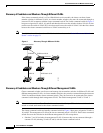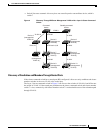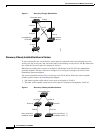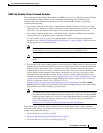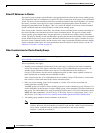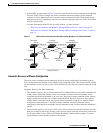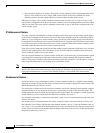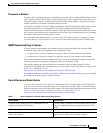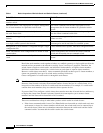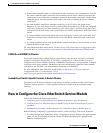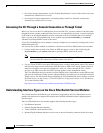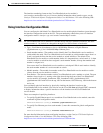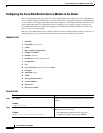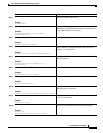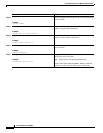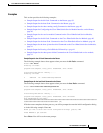
Cisco EtherSwitch Service Modules Feature Guide
Information About the Cisco EtherSwitch Service Modules
32
Cisco IOS Release 12.2(25)SEC
Recall that stack members work together to behave as a unified system (as a single switch stack) in the
network and are presented to the network as such by Layer 2 and Layer 3 protocols. Therefore, the
switch cluster recognizes switch stacks, not individual stack members, as eligible cluster members.
Individual stack members cannot join a switch cluster or participate as separate cluster members.
Because a switch cluster must have 1 cluster command switch and can have up to 15 cluster members, a
cluster can potentially have up to 16 switch stacks, totalling 144 devices.
Cluster configuration of switch stacks is through the stack master.
Note From Network Assistant or the CLI, you can configure a switch cluster to contain up to 16 switch stacks.
However, from Network Assistant, the maximum number of actual devices in a switch cluster is 16,
irrespective of the number of devices in switch stack cluster members. For example, if a switch stack
contains three stack members, they are counted as three separate devices.
If you used the CLI to configure a switch cluster that contains more than 16 actual devices and then try
to display the cluster from Network Assistant. Network Assistant requires you to remove cluster
members until the Network Assistant limit of 16 is reached.
These are considerations to keep in mind when you have switch stacks in switch clusters:
• If the cluster command switch is not a Cisco EtherSwitch service module or switch stack and a new
stack master is elected in a cluster member switch stack, the switch stack loses its connectivity to
the switch cluster if there are no redundant connections between the switch stack and the cluster
command switch. You must add the switch stack to the switch cluster.
A switch stack can be a cluster command switch or a cluster
member switch.
A switch cluster cannot be a stack master or stack member.
The stack master is the single point of complete management
for all stack members in a particular switch stack.
The cluster command switch is the single point of some
management for all cluster members in a particular switch
cluster.
The backup stack master is automatically determined in case
the stack master fails.
The standby cluster command switch must be preassigned in
case the cluster command switch fails.
A switch stack supports up to 8 simultaneous stack master
failures.
A switch cluster supports only 1 cluster command switch
failure at a time.
Stack members (as a switch stack) behave and are presented
as a single, unified system in the network.
Cluster members are various, independent switches that are
not managed as and do not behave as a unified system.
Management of stack members is integrated through a single
configuration file.
Cluster members have separate, individual configuration files.
Stack- and interface-level configurations are stored on each
stack member.
Cluster configuration are stored on the cluster command
switch and the standby cluster command switch.
New stack members are automatically added to the switch
stack.
New cluster members must be manually added to the switch
cluster.
Table 1 Basic Comparison of Switch Stacks and Switch Clusters (continued)
Switch Stack Switch Cluster



